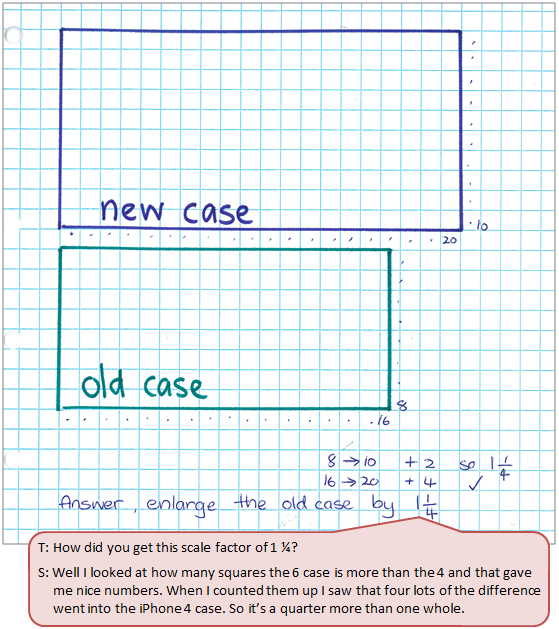A case for a new phone
The purpose of this activity is to engage the student in using a description of transformations to solve a problem.
This activity assumes the students have experience in the following areas:
- Working with transformations (reflections, rotations, translations, and enlargements).
- Choosing the correct transformations to create a design or figure.
- Describing the properties of shapes under transformations.
The problem is sufficiently open ended to allow the students freedom of choice in their approach. It may be scaffolded with guidance that leads to a solution, and/or the students might be given the opportunity to solve the problem independently.
The example responses at the end of the resource give an indication of the kind of response to expect from students who approach the problem in particular ways.

Ian made a case for his old iPhone on a 3D printer. The case has dimensions 116 mm high by 58 mm wide.
Now that he has a new iPhone, he needs a case that is 139 mm by 70 mm.
He wants to print the same case, but to fit his new phone.
Describe the transformation(s) Ian will need to tell the printer in order to make a case that fits his new phone.
The following prompts illustrate how this activity can be structured around the phases of the Mathematics Investigation Cycle.
Make sense
Introduce the problem. Allow students time to read it and discuss in pairs or small groups.
- Do I understand the situation and the words? (Students must understand that the new case is a scaled copy of the old one. That means the proportions stay the same while the side lengths increase.)
- What are the important words and symbols? (The meaning of mm as millimetres is important, as is the size of the units.)
- Do I have all the information I need? Is any information missing?
- What will my solution look like? (The solution will provide the transformation (enlargement needed with a scale factor supported by calculations.)
Plan approach
Discuss ideas about how to solve the problem. Emphasise that, in the planning phase, you want students to say how they would solve the problem, not to actually solve it.
- What else do I need to know to get started?
- What tools will be useful? Do I know how to use my tools or should I ask for help?
- How could I show this problem using numbers, pictures, graphs, tables, or materials?
- How will I record my workings in a step-by-step way?
- What strategies can I use to get started?
- What ideas do I expect to be useful for solving this problem?
- Have I already got an idea of how to solve the problem?
Take action
Allow students time to work through their strategy and find a solution to the problem.
- Is my recording clear so I do not miss anything, especially any patterns?
- Is my strategy working?
- Can I describe the transformation that makes the copy larger than the original?
- What calculations do I need to do? What will the calculation tell me?
- How can we share the mahi in our group to get the best result?
- How do my results look different to others? Why could this be?
- Does my solution make sense? Does it match my estimation?
- Does my solution answer the question?
- Is there another possible way to solve it?
Convince yourself and others
Allow students time to check their answers and then either have them pair share with other groups or ask for volunteers to share their solution with the class.
- What is the solution?
- Is my working clear for someone else to follow?
- How would I convince someone else I am correct? What argument would I use?
- Could I have solved the problem in a more efficient way?
- What connections can I see to other situations, why would this be?
- Which ideas or tools worked well in my investigation?
- What could I try differently next time? Why would I change my approach?
Examples of work
Work sample 1
The student describes, with appropriate scale factor, the enlargement needed to create the new phone cover. They calculate the scale factor using differences and fractions.
Click on the image to enlarge it. Click again to close.
Work sample 2
The student recognises the transformation needed is enlargement. They estimate the scale factor as a percentage and trials it with a photocopier to get a successful outcome.

